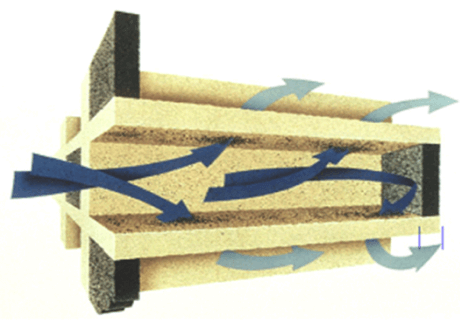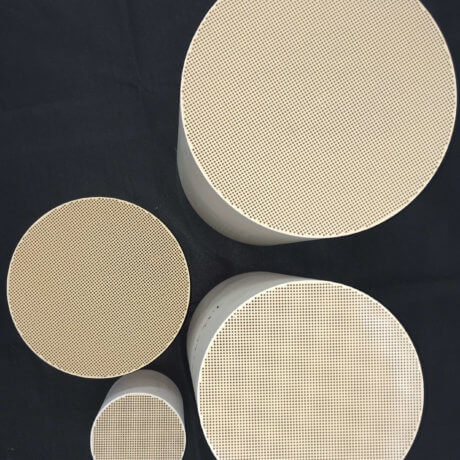Diesel exhaust contains carbon dioxide or CO2 that contributes to global warming of the planet but it also contains air pollutants that give a local problem for health. High temperatures in the combustion process gives oxides of nitrogen or NOx that can cause breathing difficulties, especially for people with asthma. Incomplete combustion of Diesel fuel gives hydrocarbons that contribute to smog in polluted areas, carbon monoxide that causes headache, dizziness and nausea, and Diesel Particulate that causes both short term and serious long term health problems.
As well as having some short term health effects such as breathing difficulties, headaches and nausea, Diesel particulate is the most dangerous component for our longer term health. It’s composed of tiny particles of carbon that are coated with some nasty hydrocarbons that are very harmful. When these particles are larger they can be seen as smoke but in modern Diesel engines they are usually too small to be seen (less than 1/50 the diameter of a human hair). These tiny particles are breathed in and get deep into our lungs, pass through into the blood stream and end up contaminating other organs. They decrease lung function, adversely affect heart function and have been linked to dementia. The WHO has also designated Diesel particulate as carcinogenic to humans increasing the risk of lung cancer.
It is estimated that Diesel particulate causes thousands of premature deaths each year in London, tens of thousands in the UK and on average reduces the lives of all EU citizens by 8 months.
Construction sites will often use Diesel powered machinery like excavators, dumpers and generators. These engines are often higher polluters than the equivalent size engines in cars and trucks because the emissions standards for construction machines have not been as stringent.The operators of this equipment and others on site are working in close proximity to the engine exhausts. Also, the machines are often used in enclosed spaces, either inside buildings, underground or surrounded by barriers to protect the public. Many of the studies into the health effects of Diesel exhaust look at workers exposed to higher concentrations through their jobs, and this includes construction. In the UK it is estimated that hundreds die of lung cancer every year due to their exposure to Diesel particulate as workers in the construction industry.
In 2018 the EU decided to impose limits on the concentration of Diesel exhaust in the workplace. In the UK, Diesel exhaust is covered by the COSHH regulations and is recognised by the HSE as a health issue in some work places. Employers have a legal duty to protect workers from concentrations of Diesel exhaust gas that can cause health effects.
Much of the official guidance, for example from the HSE, includes the recommendation to use Diesel particulate filters to reduce the health impact of Diesel exhaust in the workplace.
Most DPFs, and all that are fitted to new vehicles and construction machines, are based on a physical filtration of the particulate from the exhaust. The filter material is usually a ceramic called cordierite or silicon carbide. These materials are extruded to give many channels that run the length of the filter and then alternate channels are blocked off at either end of the filter so that the exhaust has to pass though the channel walls to leave the filter. The exhaust gas passes through the porous walls of the filter and the particulate becomes trapped in those passages and in the channels between the walls as the particulate levels build up. Cordierite and silicon carbide are used in filters because they can tolerate the high temperatures that are sometimes required to burn the trapped soot from the filter during regeneration. Some filters are made of wound fibres that are less efficient at filtering the exhaust and cannot be regenerated and so need regular replacement. All BISAF products are based on the ceramic cordierite product used by OEMs that do not require replacement.
As the filter takes particulate out of the exhaust stream, this builds up inside the filter until the pressure over the filter increases and ultimately the filter would block the flow of exhaust gas. To prevent this, the trapped particles must be removed from the filter regularly. There are two broad types of regeneration, passive and active.
Passive regeneration is where the filter is able to clean itself. This usually uses the CRT® principle, invented by Johnson Matthey, in which a special catalyst converts NO in the exhaust to NO2 which is able to react with trapped soot at normal exhaust temperatures. This is a continuous process that removes particulate as it is filtered and prevents back pressure building up. The passive process does require minimum exhaust temperatures as well as a suitable NOx to particulate ratio, which means that each retrofit application needs to be individually assessed for reliable passive regeneration.
Where an application is not deemed suitable for a passive system, then an active system is used. This is based on heating up the filter at regular intervals in order to burn off the soot. Additional heat is supplied by either electrical heating or by using a Diesel burner. Both methods require the operator to stop the machine and activate the regeneration cycle. Electrical systems require an external supply to be connected. Johnson Matthey systems cover passive as well as electrical and Diesel burner types of regeneration.
The Particulator® is a Diesel particulate filter that includes an onboard regeneration station. It connects directly to the tailpipe of the machine so is easy to install and easy to use. It has been independently tested by an automotive emissions test laboratory to give greater than 99.9% removal of particulate in Diesel exhaust.
The Particulator® has been designed to work with smaller engines up to about 30 kW in power. It can be fitted to any smaller Diesel engine used on a construction site including excavators, dumpers and generators to virtually eliminate their particulate emissions.
The Particulator® uses a ceramic wall flow filter, the same type of filter that is used by many Original equipment manufacturers for new vehicles and machines. These filters are the best available technology for removing soot particles from exhaust. Because soot builds up in the filter and increases the exhaust back pressure, it is cleaned periodically by an electric heater that burns off the trapped soot. This happens by connecting the Particulator® to an external power source and pressing the green button on the control cabinet. The process takes about 30 minutes and should be done once a day or sooner if the amber light flashes.
The Particulator® is equipped with a back pressure monitor that indicates how much soot is on the filter and when you should carry out a regeneration. When the filter has a light load of soot, the green light flashes slowly. As the soot builds up on the filter, the amber light starts to flash indicating that you need to regenerate the filter. If the soot loading reaches a high level, a red light comes on. This indicates that the filter might be damaged by regeneration and the Particulator® will need to be sent for specialist servicing. It is easiest to regenerate the Particulator® at the end of each shift even if the green light is still showing.
The Particulator® has been tested for its function by an independent automotive emissions test laboratory. Over a representative test cycle, it reduced the particulate emissions from a small excavator by more than 99.9% using both a conditioned and a recently cleaned filter. The regeneration process was also measured as being effective at cleaning the filter.
The Particulator® is also CE marked which means that all the electrical components have been tested for safe operation. The control cabinet is also tested to IP55 standard for resistance to ingress of dust and water.
Apart from regeneration that should be carried out at the end of a shift or sooner if the amber light comes on, the Particulator® does not require any owner/user maintenance. It should be returned to BISAF every 12 months for a routine service.
Once a simple frame is attached to a machine, the Particulator® may be fitted to and removed from the machine in minutes. This means that for machines that are hired out, the Particulator® may be fitted or not depending on the job and the end customer’s requirements for emissions control. This also means that one Particulator® may be used on several different machines to make best use of the asset and ensure that it is hired out frequently. Many smaller machines are used in confined and enclosed spaces where a build up of exhaust fumes would become a hazard to workers and others in the area. Being able to offer a solution to this problem can win additional hire business as well as generating revenue hiring out the Particulator.
Since 2015 London has required a minimum of EU Stage IIIA emissions standards on all construction machines between 37 kW and 560 kW working on major developments in Greater London. The requirements in the Central Activity Zone (CAZ) and Canary Wharf are tighter, requiring EU Stage IIIB machines as a minimum. From September 2020 these requirements increase by one emissions level, with EU Stage IIIB required in Greater London and EU Stage IV required in CAZ/Canary Wharf.
One of the ways of modifying an EU stage IIIA machine so that it can work in an EU Stage IIIB minimum area is to retrofit an approved DPF. This is often the simplest and lowest cost alternative and the installation can be carried out relatively quickly so that there is minimum machine downtime.
Yes, all Johnson Matthey DPFs are registered on the Energy Savings Trust approved products list for use in the London nrmm LEZ and on HS2 sites.
If you want to know anything more about these topics, then please contact us at BISAF.







